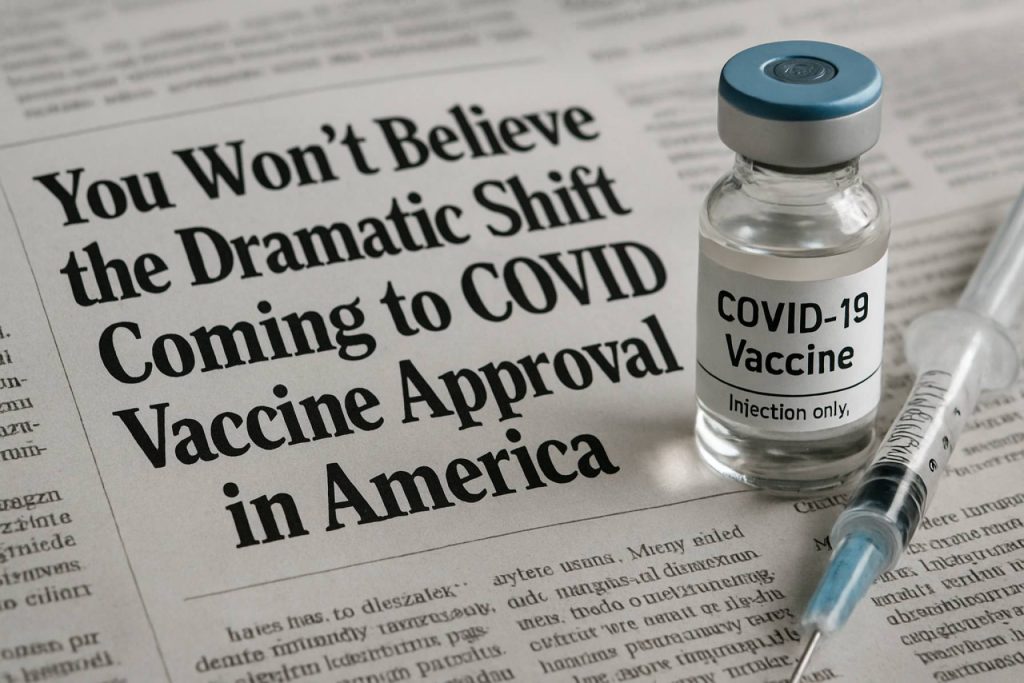
- The FDA now requires stronger clinical trial data for COVID-19 vaccine approvals, especially for healthy adults without risk factors.
- Recommendations for new COVID vaccines will primarily target people 65+, or those with chronic conditions like diabetes, heart disease, or obesity.
- This policy shift moves away from blanket recommendations, aiming for targeted, evidence-based guidance to boost public trust and vaccine uptake.
- For high-risk groups, vaccine approvals can rely on strong antibody response data, avoiding longer trials needed for healthy individuals.
- Unlike flu vaccines, COVID-19 shots may no longer require annual updates for the general population due to longer-lasting immunity.
- The new approach prioritizes transparency, real-world evidence, and protection for those most at risk.
Americans have watched the landscape of COVID-19 vaccination shift beneath their feet—first a tidal wave of urgent approvals, then booster shots, and now a quiet, seismic change at the heart of U.S. policy. The Food and Drug Administration (FDA) has just redrafted the rulebook, raising the bar for future COVID-19 vaccine approvals and, for the first time, making clear distinctions based on risk levels.
Forget the blanket recommendations of earlier pandemic years. Healthy adults with no underlying risk factors will now face a new standard: pharmaceutical companies must provide robust clinical trial data—real-world proof, not just laboratory hints—to earn the FDA’s green light for fresh COVID vaccines. Regulators have drawn a line: unless a person is over 65 or medically vulnerable—with diabetes, heart disease, obesity, or other risk factors—they’ll only see new shots recommended after rigorous trial results land on the agency’s desk.
This isn’t just policy on paper; it’s a vivid response to shifting currents. Public trust in vaccines has flagged, and fewer people are rolling up their sleeves for annual boosters. The FDA recognizes that “one-size-fits-all” recommendations have eroded confidence and failed to boost uptake. Instead of doubling down, officials now champion a targeted, evidence-based approach that echoes global best practices.
The list of high-risk conditions is extensive. Over 60% of U.S. adults have at least one chronic illness. For this vast cohort—as well as those 65 and older—the FDA will judge new vaccines by their ability to mount strong antibody responses, rather than requiring the deep, lengthy trials expected for healthy individuals. The goal: to shield the most vulnerable while avoiding overtreatment in the rest.
This new stance came into focus with Novavax’s recent protein-based COVID vaccine approval—tightened to older Americans and those 12 to 64 with specific health risks. It marked the start of a “high-risk first” era, and the new framework spells out why.
Regulators draw a sharp contrast with flu vaccine policy. Unlike influenza mutations, which spur annual reformulations and streamlined approvals, the unpredictable evolution of SARS-CoV-2 calls for a more measured, selective update schedule. The science suggests that immunity from COVID shots may last longer than previously assumed—potentially rendering yearly boosters unnecessary for much of the population.
The FDA’s new approach sets a precedent, raising the stakes for evidence and transparency while tailoring protections to those who need it most. The key message: Americans can now expect COVID vaccine recommendations that focus on real-world need, not political expedience or blanket mandates.
As this regulatory reset unfolds, one thing is clear: in the era of COVID, the right dose of evidence just may be the best medicine.
FDA’s COVID Vaccine Revolution: What the New Rules Mean for You
What to Know: Stricter Standards, Smarter COVID-19 Vaccine Recommendations
The U.S. FDA’s latest shift in COVID-19 vaccine policy marks a major change—one that impacts every American’s path to future vaccination. Here’s what you need to know, with insights beyond the headlines.
—
1. How the Approval Process Will Change
Old vs. New:
– Old Approach: Emergency Use Authorizations and blanket recommendations for nearly all adults.
– New Approach: Vaccine makers must provide extensive real-world clinical evidence for new COVID-19 shots intended for healthy adults under 65 with no risk factors. (Source: [FDA](https://www.fda.gov/))
– Targeted Trials: Only high-risk groups (65+, chronic conditions) can get new or updated vaccines without long, complex studies.
Key Takeaway:
Future COVID-19 vaccines for the general healthy population will move through a longer, more rigorous approval process—similar to what’s required for new drug approvals, not just quick lab data.
—
2. Who Is Still Eligible for Quick Access?
– High-risk individuals: Seniors 65+, those with chronic illnesses like diabetes, heart disease, obesity, cancer, chronic kidney, or lung disease.
– Over 60% of U.S. adults have at least one chronic illness (CDC data).
– Younger, healthy adults: Only get new shots if trials prove real-world effectiveness. Annual or frequent boosters are no longer the default.
—
3. Major Differences vs. Flu Vaccine Policy
– Flu Shots: Reformulated yearly based on expected strains; clinical data not required each year for approval if manufacturing process is unchanged.
– COVID-19 Vaccines: Due to unpredictable viral mutations, FDA will not recommend blanket annual boosters for all. Updates are less frequent, and only high-risk groups may see annual shots, if warranted.
—
4. Controversies & Limitations
– Vaccine Hesitancy: Trust erosion after early broad recommendations may be hard to rebuild ([KFF Survey on Vaccine Confidence](https://www.kff.org/)).
– Potential Delays: Longer trial requirements for healthy adults could slow the rollout of COVID-specific shots if new, highly virulent variants appear.
– Equity Questions: Access for at-risk but underdiagnosed individuals may be a concern.
—
5. What About Existing COVID-19 Vaccines?
– No Impact on Past Protection: Existing EUA/approved vaccines and boosters already on the market remain available (subject to updated CDC recommendations).
– Shelf Life and Supply: Some COVID vaccines have unused supply due to lower demand—waste and overordering have been documented by [GAO](https://www.gao.gov/).
—
6. Security, Sustainability, and Real-World Use
– Waste Reduction: Fewer, better-targeted shots = less waste and lower cost to taxpayers.
– Global Model: The FDA is aligning with regulators in the EU, Canada, and Australia, emphasizing evidence for risk-based policy.
—
7. Predictions & Industry Impact
– Market Forecasts: COVID vaccine revenues may shrink as healthy populations no longer require yearly boosters—analysts at Morgan Stanley and Pfizer have signaled market corrections.
– Innovation Pressure: Vaccine makers must deliver better, longer-lasting shots and produce robust evidence for non-high-risk groups.
– Possible Research Focus: Multi-valent or pan-coronavirus vaccines could become the next frontier to streamline booster cycles.
—
8. Common Reader Questions Answered
Q: Do I need a COVID shot this year if I am under 65 and healthy?
A: Not unless there is compelling, real-world evidence from new trials. Annual boosters are not the default.
Q: How are “high-risk” conditions defined?
A: Chronic illnesses with proven vulnerability—CDC includes diabetes, obesity, heart/lung/kidney disease, cancer, and advanced age.
Q: Are current vaccines still effective?
A: For at-risk populations and older adults, annual boosters are still recommended. For healthy, young adults, current immunity is considered robust unless significant new data emerges.
Q: Will this new approach put people at higher risk?
A: For most healthy adults, the risk is low and can be managed with current vaccines. The FDA’s aim is to avoid unnecessary shots.
Q: Can employers or schools still require COVID shots?
A: This is a separate legal/policy question. The FDA rules guide availability and recommendations—not mandates.
—
9. How-To: Stay Protected Against COVID-19 in the New Era
Step 1: Review your health profile & discuss with your doctor if you are at higher risk.
Step 2: Monitor for updated CDC and FDA guidance, especially heading into fall/winter.
Step 3: Keep record of your vaccination dates—immunity typically lasts 6-12 months for most people.
Step 4: Practice smart risk management (masking, ventilation, testing) during outbreaks if you are vulnerable.
—
10. Pros & Cons of the New FDA COVID-19 Vaccine Policy
Pros:
– Greater trust through transparency and real-world data
– Less risk of overtreatment or side effects for low-risk groups
– Major cost savings for public health budgets
– Focus on most vulnerable populations
Cons:
– Potential slower access to future shots for healthy adults if dangerous new variants evolve quickly
– Could be confusing for the public during policy transition
– May leave out underdiagnosed/high-risk individuals who are unaware
—
Actionable Quick Tips
– Check your eligibility: Know if you’re considered high-risk for COVID complications.
– Stay informed: Follow credible sites like the [CDC](https://www.cdc.gov/) and [FDA](https://www.fda.gov/) for new vaccine updates.
– Advocate wisely: Encourage at-risk friends/family to prioritize boosters if eligible.
– Reduce exposure: Maintain good hygiene and consider masks in high-risk situations.
—
Suggested Related Links
– [FDA](https://www.fda.gov/)
– [CDC](https://www.cdc.gov/)
– [World Health Organization](https://www.who.int/)
– [KFF](https://www.kff.org/)
—
Final Recommendation
The FDA’s tailored, evidence-based COVID-19 vaccine regulations aim to rebuild public trust and protect those at highest risk. Americans should consult credible sources, stay updated on recommendations, and make vaccination decisions based on personal health status and new scientific evidence.
—
Stay safe, stay informed, and let real-world evidence guide your health choices in a post-pandemic world.



